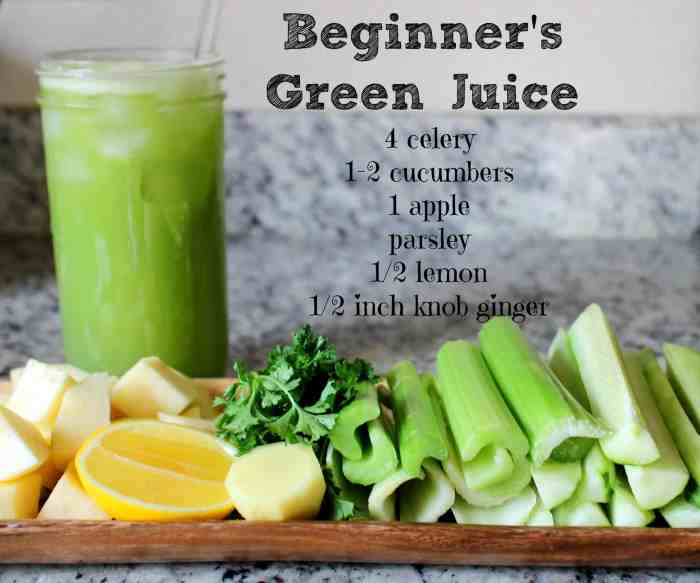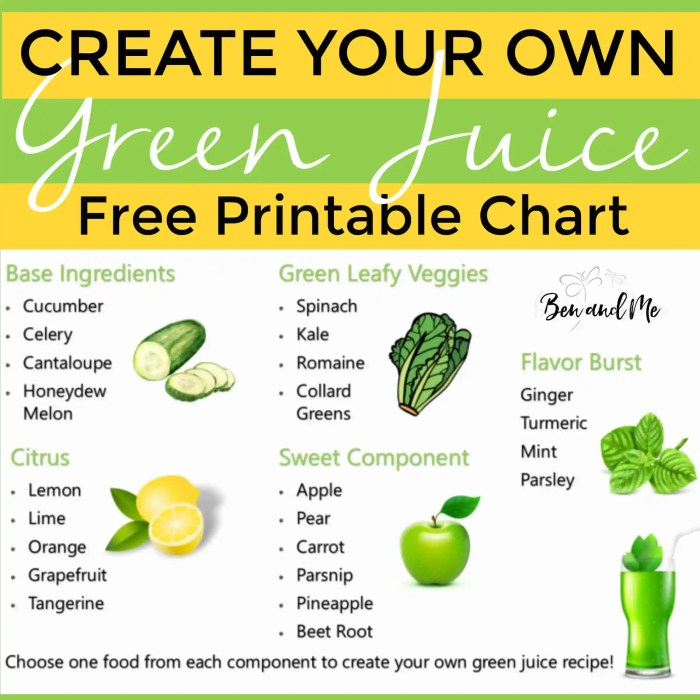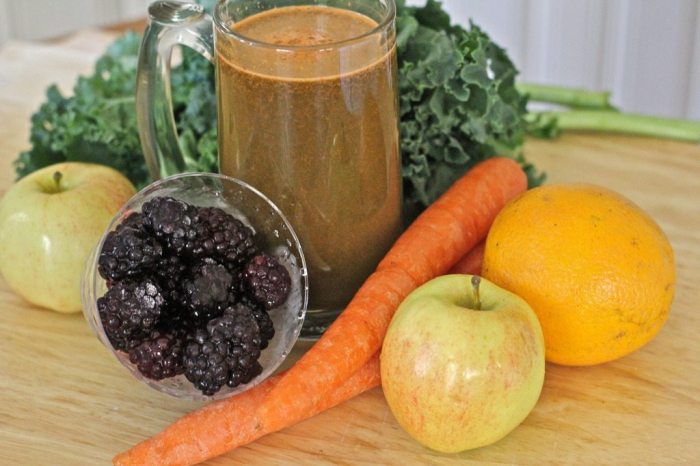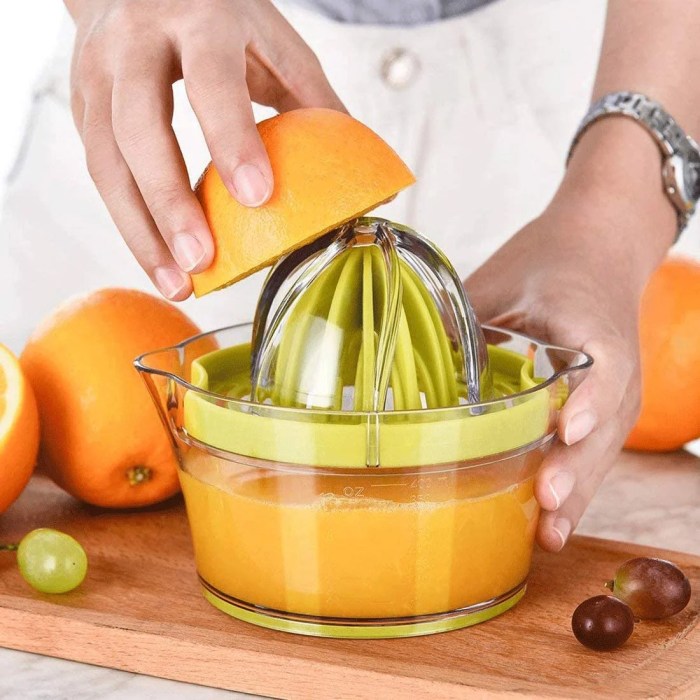Juicer recipes open a world of vibrant flavors and nutritional benefits. From invigorating green juices to sweet and refreshing fruit blends, there’s a recipe for every taste and health goal. Juicing allows you to pack a punch of vitamins, minerals, and antioxidants into a single glass, making it a convenient and delicious way to boost your health.
This comprehensive guide delves into the fascinating world of juicing, exploring the different types of juicers, providing easy-to-follow recipes for beginners, and offering tailored recipes for various health benefits, including weight loss, detoxification, and skin health. We’ll also cover essential tips and tricks for maximizing juice quality and flavor, as well as safety precautions to ensure a healthy and enjoyable juicing experience.
Introduction to Juicing
Juicing is a process that extracts the juice from fruits, vegetables, and other plants by using a juicer. This juice is then consumed as a beverage. Juicing has become increasingly popular in recent years, as people seek healthier and more convenient ways to incorporate fruits and vegetables into their diets.
Juicing offers several potential health benefits, including increased nutrient intake, improved digestion, and enhanced energy levels.
The Difference Between Juicing and Blending
Juicing and blending are both popular methods for consuming fruits and vegetables, but they differ significantly in their processes and outcomes.Juicing separates the pulp from the juice, resulting in a liquid beverage that is easy to digest and absorb. Blending, on the other hand, combines all the ingredients, including the pulp, into a thicker smoothie.Here’s a table summarizing the key differences:
| Feature | Juicing | Blending |
|---|---|---|
| Process | Separates pulp from juice | Combines all ingredients |
| Consistency | Liquid | Thick smoothie |
| Nutrient Absorption | Higher, as the juice is easily absorbed | Lower, as the pulp can be difficult to digest |
| Fiber Content | Low, as the fiber is removed | High, as the pulp contains fiber |
The History of Juicing
The practice of juicing dates back centuries, with evidence suggesting that it was used in ancient civilizations for medicinal purposes.
- In ancient India, Ayurveda, a traditional system of medicine, emphasized the use of juices for their therapeutic properties.
- In ancient Greece, Hippocrates, the father of medicine, recommended juice therapies for various ailments.
- The modern juicing movement gained momentum in the early 20th century, with the development of electric juicers.
Juicing has evolved significantly over the years, with advancements in juicer technology and a growing awareness of the potential health benefits of consuming fresh juice.
Types of Juicers
Juicers are essential tools for extracting juice from fruits and vegetables, providing a convenient way to enjoy a concentrated dose of nutrients. There are several types of juicers available, each with its unique features, advantages, and drawbacks. Understanding the different types can help you choose the best juicer for your needs and preferences.
Centrifugal Juicers
Centrifugal juicers are the most common and affordable type. They work by using a high-speed spinning blade to shred fruits and vegetables, forcing the juice through a strainer.
- Pros:Centrifugal juicers are generally inexpensive, easy to use, and quick. They can handle a wide variety of fruits and vegetables, including leafy greens.
- Cons:The high speed of centrifugal juicers can generate heat, which can degrade some nutrients. They also tend to produce more pulp than other types of juicers.
Popular brands and models include:
- Breville JE98XL Juice Fountain Plus:This juicer is known for its powerful motor and large capacity.
- Hamilton Beach 67601A Big Mouth Juice Extractor:This juicer is designed for easy cleaning and features a wide feed chute.
Masticating Juicers
Masticating juicers, also known as cold-press juicers, use a slow-rotating auger to crush and press fruits and vegetables.
- Pros:Masticating juicers are known for producing juice with a higher nutrient content and less oxidation. They also produce less pulp and foam.
- Cons:Masticating juicers are typically more expensive and slower than centrifugal juicers. They may also be more difficult to clean.
Popular brands and models include:
- Omega J8006HDS Juicer:This juicer is known for its durability and ability to extract juice from wheatgrass and leafy greens.
- Kuvings Whole Slow Juicer:This juicer is designed for ease of use and features a large feed chute.
Cold-Press Juicers
Cold-press juicers are a type of masticating juicer that uses a low-speed, high-pressure system to extract juice.
- Pros:Cold-press juicers are known for producing juice with the highest nutrient content and minimal oxidation. They also produce a very clear juice with minimal pulp.
- Cons:Cold-press juicers are the most expensive type of juicer and are typically the slowest.
Popular brands and models include:
- Hurom HP Slow Juicer:This juicer is known for its quiet operation and ability to extract juice from a wide variety of fruits and vegetables.
- NutriBullet Pro 900:This juicer is known for its versatility and ability to blend and juice.
Juicing Recipes for Beginners
Juicing is a great way to get your daily dose of fruits and vegetables. It’s a simple and easy way to add more nutrients to your diet, and it can be customized to your taste preferences. If you’re new to juicing, start with simple recipes that use common fruits and vegetables.
You can gradually experiment with different ingredients as you become more comfortable with the process.
Simple Juicing Recipes for Beginners
Here are a few easy-to-follow juicing recipes that use common fruits and vegetables.
Green Juice
This green juice is packed with nutrients and is a great way to start your day.
- 1 cup spinach
- 1/2 cup romaine lettuce
- 1/2 cucumber
- 1 apple, cored
- 1/2 lemon, peeled
Citrus Blast
This citrus blast is a refreshing and energizing juice.
- 1 orange, peeled
- 1/2 grapefruit, peeled
- 1/2 lemon, peeled
- 1/4 cup pineapple, cored
Berry Delight
This berry delight is a sweet and delicious juice.
- 1 cup frozen berries (strawberries, blueberries, raspberries)
- 1/2 banana
- 1/4 cup pineapple, cored
- 1/2 cup water
Tips for Adjusting Juicing Recipes
Here are a few tips for adjusting juicing recipes to your personal preferences:
- Adjust the sweetness: Add more fruit to make your juice sweeter or add a little honey or maple syrup.
- Adjust the thickness: Add more water or ice to make your juice thinner or add more vegetables to make it thicker.
- Experiment with different ingredients: Try adding different fruits, vegetables, and herbs to your juice to create unique flavor combinations.
- Don’t be afraid to get creative: Juicing is a great way to experiment with different flavors and textures. Don’t be afraid to try new things!
Juicing Recipes for Health Benefits
Juicing can be a great way to boost your health and wellness. By consuming concentrated nutrients from fruits and vegetables, you can support various bodily functions and improve overall well-being. Here are some juicing recipes specifically designed to target different health benefits.
Boosting Immunity, Juicer recipes
Consuming nutrient-rich juices can help strengthen your immune system, making you less susceptible to illnesses.
- Citrus Immunity Booster: This juice is packed with vitamin C, a powerful antioxidant that helps fight off infections.
- Ingredients: 1 orange, 1 grapefruit, 1 lemon, 1/2 inch ginger
- Instructions: Combine all ingredients in a juicer and blend until smooth. Enjoy immediately.
- Green Power Juice: This juice is rich in vitamins, minerals, and antioxidants, promoting overall immune function.
- Ingredients: 1 cup spinach, 1/2 cucumber, 1 apple, 1/2 lemon, 1/2 inch ginger
- Instructions: Combine all ingredients in a juicer and blend until smooth. Enjoy immediately.
Improving Digestion
Certain juices can aid in digestion by promoting gut health and reducing inflammation.
- Beetroot and Ginger Digestive Juice: This juice is known to improve digestion by stimulating the production of digestive juices and reducing bloating.
- Ingredients: 1 beetroot, 1 apple, 1/2 inch ginger, 1/2 cup water
- Instructions: Combine all ingredients in a juicer and blend until smooth. Enjoy immediately.
- Pineapple and Turmeric Digestive Juice: This juice contains bromelain, an enzyme found in pineapple, which aids in digestion, and turmeric, a potent anti-inflammatory agent.
- Ingredients: 1 cup pineapple, 1/2 inch turmeric, 1/2 lemon, 1/2 cup water
- Instructions: Combine all ingredients in a juicer and blend until smooth. Enjoy immediately.
Boosting Energy Levels
Some juices can provide a quick energy boost due to their high concentration of vitamins, minerals, and natural sugars.
- Energy-Boosting Citrus Juice: This juice is packed with vitamin C and natural sugars, providing a quick energy boost.
- Ingredients: 1 orange, 1 grapefruit, 1/2 lemon, 1/2 cup water
- Instructions: Combine all ingredients in a juicer and blend until smooth. Enjoy immediately.
- Banana and Spinach Energy Juice: This juice is a great source of potassium, which is essential for muscle function, and iron, which helps carry oxygen throughout the body.
- Ingredients: 1 banana, 1 cup spinach, 1/2 apple, 1/2 cup water
- Instructions: Combine all ingredients in a juicer and blend until smooth. Enjoy immediately.
Juicing for Weight Loss

Juicing can be a helpful tool for weight loss, but it’s not a magic bullet. While juicing can help you consume more fruits and vegetables, which are essential for a healthy diet, it’s crucial to understand its role in weight management and incorporate it strategically into your overall healthy lifestyle.
Juicing’s Role in Weight Loss
Juicing can contribute to weight loss by providing a concentrated source of nutrients and fiber, potentially leading to increased satiety and reduced calorie intake. It can also help you consume more fruits and vegetables, which are naturally low in calories and rich in vitamins and minerals.
Discover how tips biar langgeng sama pacar has transformed methods in this topic.
However, it’s essential to note that juicing alone is not a sustainable weight loss solution.
Weight Management Juicing Recipes
Here are some juicing recipes that can be incorporated into a weight management plan:
- Green Detox Juice:This juice is packed with antioxidants and fiber, which can help you feel fuller for longer. Blend together 1 cup spinach, 1/2 cup cucumber, 1/4 cup celery, 1/2 green apple, and 1/2 lemon.
- Citrus Burst Juice:This refreshing juice is low in calories and high in vitamin C. Blend together 1 orange, 1 grapefruit, 1/2 lemon, and 1/4 cup water.
- Tropical Green Smoothie:This smoothie is a delicious and nutritious way to start your day. Blend together 1 cup frozen mango, 1/2 cup pineapple, 1/4 cup spinach, 1/2 banana, and 1/2 cup coconut water.
Tips for Incorporating Juicing into a Healthy Diet
Here are some tips for incorporating juicing into a healthy diet for weight management:
- Choose your fruits and vegetables wisely:Opt for fruits and vegetables that are naturally low in calories and high in fiber, such as berries, leafy greens, and cucumbers.
- Limit added sugars:Avoid adding excessive sugars or sweeteners to your juices.
- Drink your juice in moderation:Juicing should be a part of a balanced diet, not a replacement for whole foods.
- Combine juicing with other healthy habits:Incorporate regular exercise, a balanced diet, and adequate sleep into your routine for optimal weight management.
Juicing for Detoxification

Juicing is often touted as a way to cleanse and detoxify the body. While it’s true that juicing can provide a concentrated dose of nutrients, it’s important to understand that the concept of detoxifying through juicing is a complex one.
The human body has natural detoxification mechanisms, and juicing alone may not be a magic bullet for removing toxins.
Understanding Detoxification
Detoxification is a natural process that your body constantly performs to eliminate harmful substances. Your liver and kidneys play a crucial role in this process. While juicing can contribute to overall health and well-being, it’s not a replacement for healthy lifestyle habits.
Recipes to Support Liver and Kidney Function
Juicing can be a way to incorporate foods that support liver and kidney function. Here are some recipes that focus on ingredients known for their detoxifying properties:
Liver-Supporting Juice
* 1 cup beetroot
- 1/2 cup red apple
- 1/4 cup ginger
- 1/4 cup lemon juice
This juice is rich in antioxidants and nitrates, which may help protect the liver from damage.
Kidney-Supporting Juice
* 1 cup cucumber
- 1/2 cup celery
- 1/4 cup parsley
- 1/4 cup lemon juice
This juice is a good source of electrolytes and diuretics, which can help flush out toxins and support kidney function.
Safe and Effective Detoxification Practices
While juicing can be a part of a healthy lifestyle, it’s essential to prioritize safe and effective detoxification practices. Here are some key points to consider:* Hydration:Drinking plenty of water is crucial for flushing out toxins. Aim for at least eight glasses of water per day.
Fiber-Rich Diet
Include plenty of fiber in your diet through fruits, vegetables, and whole grains. Fiber helps bind to toxins and remove them from the body.
Balanced Diet
Focus on a balanced diet that includes a variety of fruits, vegetables, lean proteins, and whole grains.
Regular Exercise
Exercise promotes sweating, which can help eliminate toxins.
Adequate Sleep
Getting enough sleep is essential for overall health and detoxification.
Stress Management
Chronic stress can negatively impact detoxification processes. Practice stress-reducing techniques like meditation or yoga.
Consult a Healthcare Professional
Before starting any detoxification program, consult a healthcare professional to ensure it’s safe and appropriate for you.
Juicing for Skin Health

Juicing can be a delicious and effective way to nourish your skin from the inside out. By consuming nutrient-rich fruits and vegetables, you can provide your body with the vitamins, minerals, and antioxidants it needs to maintain healthy, radiant skin.
The Link Between Juicing and Healthy Skin
Juicing offers a concentrated dose of essential nutrients that contribute to skin health. Antioxidants in fruits and vegetables fight free radicals that damage skin cells, leading to wrinkles, fine lines, and uneven skin tone. Vitamins like C and E promote collagen production, which keeps skin firm and elastic.
Juices rich in beta-carotene, found in carrots and sweet potatoes, convert to vitamin A in the body, supporting skin cell growth and repair.
Recipes for Skin Radiance and Hydration
- Carrot-Ginger-Apple Juice:This juice is rich in beta-carotene, vitamin C, and antioxidants. The ginger adds a spicy kick and aids digestion.
- Green Smoothie with Spinach, Kiwi, and Banana:Spinach is packed with vitamin C and antioxidants, while kiwi provides vitamin E and banana adds potassium for hydration.
- Beetroot-Berry Juice:Beets are a great source of vitamin C and nitrates, which improve blood flow and oxygenation to the skin. Berries are packed with antioxidants.
Tips for Using Juice as a Topical Skin Treatment
- Cucumber Juice:Cucumber is known for its hydrating and soothing properties. Apply cucumber juice directly to your skin to reduce puffiness and redness.
- Aloe Vera Juice:Aloe vera is a natural anti-inflammatory and moisturizer. Apply aloe vera juice to sunburns, acne, and other skin irritations.
- Tomato Juice:Tomatoes are rich in lycopene, a powerful antioxidant that protects skin from sun damage. Apply tomato juice to your skin as a natural sunscreen.
Juicing Tips and Tricks
Juicing can be a fun and healthy way to get your daily dose of fruits and vegetables. However, there are a few tips and tricks that can help you maximize juice quality, flavor, and freshness. By following these guidelines, you can ensure that your juicing journey is both enjoyable and beneficial.
Maximizing Juice Quality and Flavor
The quality and flavor of your juice are directly influenced by the ingredients you use. Fresh, ripe produce will yield the best results. Here are some tips for maximizing juice quality and flavor:
- Choose fruits and vegetables that are in season. Seasonal produce is typically more flavorful and nutritious.
- Wash and prepare your produce thoroughly before juicing. Remove any stems, seeds, or peels that you don’t want in your juice.
- Experiment with different combinations of fruits and vegetables. Don’t be afraid to try new things and find what you like best.
- Add a pinch of salt or a squeeze of lemon juice to enhance the flavor of your juice.
- Use a high-quality juicer that can extract the maximum amount of juice from your produce.
Preserving Juice Freshness
Freshly squeezed juice is best, but it can be difficult to consume it all immediately. Here are some tips for preserving juice freshness:
- Store your juice in an airtight container in the refrigerator. Juice can last for up to 24 hours in the refrigerator.
- Avoid exposing your juice to direct sunlight or heat, as this can cause it to spoil faster.
- You can also freeze your juice for later use. Simply pour it into ice cube trays and freeze until solid. Once frozen, you can transfer the cubes to a freezer-safe bag.
- To prevent oxidation, add a small amount of lemon juice or apple cider vinegar to your juice before storing it.
Cleaning and Maintaining Juicers
Proper cleaning and maintenance are essential for keeping your juicer in top condition and preventing the growth of bacteria. Here are some tips for cleaning and maintaining your juicer:
- Clean your juicer immediately after use. The longer you wait, the harder it will be to remove any stuck-on residue.
- Disassemble your juicer according to the manufacturer’s instructions. Some juicers have removable parts that can be washed in the dishwasher, while others require hand washing.
- Use a soft-bristled brush to clean any hard-to-reach areas. Avoid using abrasive cleaners or sponges, as these can damage the juicer’s parts.
- Rinse all parts thoroughly with warm water and dry them completely before reassembling the juicer.
- Store your juicer in a cool, dry place when not in use.
Juicing Safety and Precautions

Juicing, while a healthy and delicious way to consume fruits and vegetables, comes with certain risks. Understanding these risks and taking necessary precautions is crucial to ensure a safe and enjoyable juicing experience.
Potential Risks Associated with Juicing
Juicing, despite its health benefits, can pose some potential risks if not done correctly. It is important to be aware of these risks and take necessary precautions to minimize them.
- Nutrient Loss:Juicing removes the fiber from fruits and vegetables, which is an essential nutrient for digestion and overall health. This can lead to a reduction in the overall nutritional value of the juice.
- Sugar Content:Juicing concentrates the natural sugars present in fruits and vegetables. Excessive consumption of fruit juice can contribute to weight gain and other health problems.
- Allergies:Juicing can trigger allergic reactions in individuals with sensitivities to certain fruits or vegetables. It is important to be aware of your allergies and avoid ingredients that can cause adverse reactions.
- Tooth Decay:The high sugar content in some juices can contribute to tooth decay. It is recommended to drink juice through a straw and rinse your mouth with water afterward.
- Gastrointestinal Issues:Some people may experience gastrointestinal discomfort, such as diarrhea or bloating, after consuming large amounts of juice.
Choosing Safe and High-Quality Ingredients
Selecting safe and high-quality ingredients is essential for a healthy and enjoyable juicing experience.
- Organic Produce:Opting for organic produce minimizes exposure to pesticides and other harmful chemicals.
- Freshness:Use fresh, ripe fruits and vegetables for the best flavor and nutritional value.
- Washing and Cleaning:Thoroughly wash all produce before juicing to remove dirt, bacteria, and pesticides.
- Storage:Store juice in the refrigerator and consume it within 24 hours to maintain freshness and nutritional value.
Managing Allergies and Dietary Restrictions
For individuals with allergies or dietary restrictions, juicing requires careful planning and attention to ingredients.
- Read Labels:Carefully read labels on pre-packaged juices to ensure they do not contain ingredients that you are allergic to or need to avoid.
- Cross-Contamination:Avoid cross-contamination by using separate cutting boards and utensils for different ingredients, especially if you have allergies.
- Consult with a Healthcare Professional:If you have any concerns about allergies or dietary restrictions, consult with a healthcare professional or registered dietitian for personalized guidance.
Juicing Resources and Inspiration: Juicer Recipes
Juicing is a popular trend, and it’s easy to find information and inspiration to help you get started. Whether you’re looking for recipes, tips, or just some motivation, there are plenty of resources available online and in print.There are many ways to find juicing resources and inspiration.
You can find a wealth of information online, in books, and even in your local community.
Juicing Websites and Blogs
Juicing websites and blogs offer a wide range of information, from basic juicing tips to advanced recipes and health benefits. They can also provide a community of like-minded individuals who share their experiences and recipes. Here are some reputable juicing websites and blogs:
- The Juice Plus+ Blog:This blog offers a variety of juicing recipes, tips, and information about the health benefits of juicing.
- Juice Press:This website offers a variety of recipes, tips, and information about juicing.
- The Green Smoothie Girl:This blog offers a variety of green smoothie recipes, tips, and information about the health benefits of juicing.
- The Healthy Foodie:This blog offers a variety of recipes, tips, and information about juicing and other healthy eating habits.
Juicing Books and Cookbooks
Juicing books and cookbooks can provide a comprehensive guide to juicing, with recipes, tips, and information about the health benefits of juicing. Here are some popular juicing books and cookbooks:
- The Complete Idiot’s Guide to Juicing:This book provides a comprehensive guide to juicing, covering everything from choosing the right juicer to creating delicious and healthy juice recipes.
- The Juicing Bible:This book provides a comprehensive guide to juicing, with recipes, tips, and information about the health benefits of juicing.
- Juicing for Dummies:This book provides a comprehensive guide to juicing, covering everything from choosing the right juicer to creating delicious and healthy juice recipes.
- The Juicing Handbook:This book provides a comprehensive guide to juicing, with recipes, tips, and information about the health benefits of juicing.
Juicing Inspiration
To get inspired for new juice combinations, try thinking about flavors you enjoy and experimenting with different ingredients. You can also look to other cuisines for inspiration, such as Asian, Mexican, or Indian cuisine.Here are some tips for creating innovative and delicious juice combinations:
- Start with a base:Use a base of leafy greens, such as spinach, kale, or romaine lettuce.
- Add fruits for sweetness:Use fruits such as apples, oranges, berries, or bananas.
- Add vegetables for flavor:Use vegetables such as carrots, celery, cucumbers, or beets.
- Add spices for an extra kick:Use spices such as ginger, turmeric, or cinnamon.
- Use seasonal ingredients:Use seasonal ingredients to ensure your juices are fresh and flavorful.
Conclusion

Embark on a juicing journey filled with flavor, health, and vitality! Whether you’re a seasoned juicing enthusiast or just starting out, this guide equips you with the knowledge and inspiration to create delicious and nutritious juices that nourish your body and mind.
So grab your juicer, gather your favorite fruits and vegetables, and get ready to unlock a world of healthy and flavorful possibilities!
